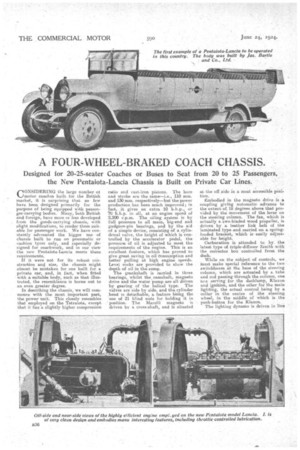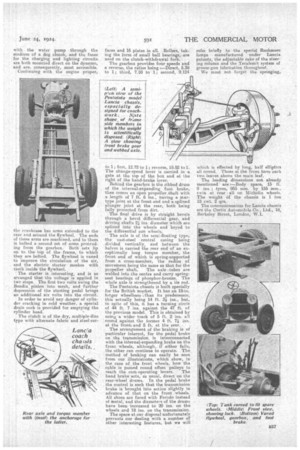A FOUR-WHEEL-BRAKED COACH CHASSIS.
Page 22

Page 23

If you've noticed an error in this article please click here to report it so we can fix it.
Designed for 20-25-seater Coaches or Buses to Seat from 20 to 25 Passengers, the New Pentaiota-Lancia Chassis is Built on Private Car Lines.
riONSIDERING the large number ot 1.....Onaot.or coaches built. for the British market, it is surprising that si . few liav5 been designed primarily for the purpose of being equipped with pas.senger-earrying bodies, Many, both British and foreign, have more or less developed from the goods-carrying chassis, with slight modifications, to render them suitable for passm)ger work, We have constantly advocated the bigger use of chassis built to run on pneumatic or cushion tyres only, and especially designed for coachwork, and in our view the new Pentaiota-Lancia meets these requirenients.
If it were not. for its robust con&traction and size, the chassis might almost be mistaken for one built for, a private car, and, in f ant, when fitted with a suitable body, such as that illustrate:a, the resemblance is borne out to an even greater degree.
In describing the chassis, we will commence with the most important part, the power. unit: This closely resembles that employed on the Tetraicita, except that it has.a slightly higher compression
ratio and east-iron pistons. The bore and stroke are the same—i.e., 110 mm. and 130 mm. respectively—but the power production has been much improved; in fact, it gives an extra 10 b.h.p., or 70 b.h.p. in all, at an engine speed of 2,200 r.p.m. The oiling system is by full pressure to all main, big-end and gudgeon-pin bearings, and by the aid of a simple device, consisting of a cylindrical valve, the height of which is controlled by the accelerator pedal, the pressure of oil is acbusted to meet the requirements of the engine. This is an excellent, 1 eature, which has proved to give great saving in oil consumption and better pulling at high engine speeds. Level cocks are provided to show the depth of oil in the sump.
The 9rankshaft is carried in three bearings, whilst the camshaft, magneto drive and the water pump are all driven by gearing of the helical type. The valves are side by side, and the, cylinder head is detachable, a. feature being the use of 21 blind nuts for holding it in position. The Marelli magneto is driven by a cross-shaft, and is situated at the off side in a most accessible posi, tion. • Embodied in the magneto drive is a coupling giving automatic advance to the extent of 143 degrees above that provided by the movement of the lever on the steering column The fan, which is actually a two-bladed wood propeller, is driven by a. leather link belt of the laminated type and carried on a springloadedbracket, which is easily adjustable for height. Carburation is attended to by the latest type of triple-diffuser Zenith with the corrector box controlled from the clash.
While on the subject of controls, we nest make special reference to the two switclaboxes at. the base of the steering column, which are actuated by a tube and rod passing through the column, one box serving for the dashlamp, Klaxon and ignition, and the other for the main lighting, the actual control being by a collar in the centre of the steering wheel, in the middle of which is the push-button for the Klaxon. The lighting dynamo is driven in line with the water pump through the medium of a dog clutch, and the fuses for the charging and lighting circuits are both mounted direct on the dynamo, and are, consequently, most accessible. Continuing with the engine proper,
the crankcase has arms extended to the rear and around the flywheel. The ends of these arnis are machined, and to them is bolted a second set of arms protruding from the gearbox. Both sets Iip on to the top of the ,frame, to which they are bolted. The flywheel is vaned to improve the circulation of the air, and the electric starter meshes with teeth inside the flywheel.
The starter is interesting, and is so artanged that the voltage is applied in two steps. The first two volts swing the Bendix pinion into mesh, and further depression of the starting pedal brings an additional six volts into the eirenit.
In order to avoid any danger of cylinder cracking in cold weather, a special drain cock is provided for emptying the cylinder head.
The clutch is of the dry, multiple-disc type with alternate fabric and steel sur faces and 16 plates in all. Rollers, taking the form of small ball bearings, are used on the clutch-withdrawal fork.
The gearbox provides four speeds and a reverse, the ratios being i—Direct, 5.3E1 to 1; third, 7.10 to 1; second, 9.124 to 1; first, 12.72 to 1; reverse, 15.82 to 1. The change-speed lever is carried in a gate at the top of the box and at the right of the hand-brake lover.
Behind the gearbox is the ribbed drum of the internal-expanding foot brake, then comes an open propeller.shaft with a. length of 7 ft. 6 ins., having a startype joint at the front end and a spill-led plunger joint at the rear, both being fully protected from dirt.
The final drive is by straight bevels through a bevel differential gear, and driving shafts 24 ins. diameter which are splined into the wheels and 'keyed to the differential sun wheels.
The axle is of the semi-floating type, the cast-steel 'central easing being divided vertically, and between the halves is carried the rear end of an exceptionally long torque member, the front end of which is spring-supported from a cross-member, the radius of movement being the same as that for the
propeller shaft. The axle ;tubes are welded into the centre and carry springseat hearings of phosphor-bronze. The whole axle is strengthened by a tie rod. The Pentainta chassis is built specially for the British market. It has an 18-in. longer wheelbase -,than its predecessor, this actually being 14 ft. 5i ins., but, in spite of this, it has a turning circle of 44 ft. 7 ins, against the 47 ft. of the previous model. This is obtained by using a wider track of 5 ft. 2 ins, all round against the former 4 ft. 7A. ins..
at the fronts and '5 ft. at the rear. , The arrangement of the. braking is of particular interest, for the pedal brake on the transmission is interconnected with the internal-expanding brake on the front wheels, although,. if either fails, the other can continue to operate. The method of braking can easily be seen from our illustrations, which show, in the case of the front wheels, how the cable is passed round offset pulleys to reach the cam-operating 'levers. The hand brake acts, as usual, direct on the rear-wheel drums. In the pedal brake the control is such that the transmission brake is brought into action slightly in advance of that on the front wheels. All shoes are faced with Ferodo instead of meta), and the diameters of the drums have been increased to 20 ins, on the wheels. and 18 ins, on the transmission.
The space at our disposal unfortunately prevents our .dealing with a number of other interesting features, but we will
rofes briefly to the special Rushmore lamps manufactured under Lancia patents, the adjustable rake of the steering column and the Tecalemit system of grease gan lubrication throughout.
We must not forget the springing, which is effected by long, half ellipties all round, Those at the front have each two leaves above the main leaf.
The leading dimensions not already mentioned' are :—Body space, 15 ft. 9 ins.; tyres, 955 mm. by 155 mm., twin at rear all on Michelin wheels. The weight of the chassis is 1 ton 18 cwt. 2 qrs. The concessionnaires for Lancia chassis are the Curtis Automobile Co., Ltd., 18, Berkeley Street, London, W.I.






























